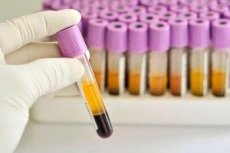Medical expert of the article
New publications
Accelerated S.O.E. Syndrome
Last reviewed: 04.07.2025

All iLive content is medically reviewed or fact checked to ensure as much factual accuracy as possible.
We have strict sourcing guidelines and only link to reputable media sites, academic research institutions and, whenever possible, medically peer reviewed studies. Note that the numbers in parentheses ([1], [2], etc.) are clickable links to these studies.
If you feel that any of our content is inaccurate, out-of-date, or otherwise questionable, please select it and press Ctrl + Enter.

When visiting medical institutions for preventive purposes, or when visiting a doctor with complaints, the most common laboratory test is a general laboratory blood test, in our case, the test is ESR, which means the erythrocyte sedimentation rate. Previously, this method was called ESR - erythrocyte sedimentation reaction. ESR is a non-specific blood indicator and does not indicate the presence of a specific pathology. ESR norms may depend on the patient's gender and age. The most common deviations from the norm are an increased ESR indicator or a decreased ESR indicator.
There are cases when the ESR value is greatly increased without any apparent reason. In medicine, this deviation from the norm is called accelerated ESR syndrome.
In this article, we propose to understand in more detail the causes of the syndrome, as well as its symptoms, treatment and prevention. For this, a little more detailed information about the clinical study of ESR: laboratory methods of determination, its normal values.
The most common methods by which the erythrocyte sedimentation rate can be determined in laboratory conditions are: Panchenkov and Westergren methods. Panchenkov's method is based on the property of erythrocyte aggregates to settle at a certain speed to the bottom of the vessels. For this study, capillary blood is taken from a finger, diluted in a special sodium citrate solution, and placed in a glass capillary. For Westergren's method, venous blood is taken, which is examined in a special laboratory tube 200 mm long.
The following ESR norms are considered generally accepted:
- adult males 1-10 mm/h
- adult women – 15 mm/h
- persons over 75 years old up to 20 mm/h
- children - 3- 12 mm/h.
Epidemiology
Medical statistics provide data that 5-10% of healthy people may have an elevated ESR for a fairly long time. Elderly patients with the syndrome may be recommended traditional medicine.
 [ 1 ]
[ 1 ]
Causes of accelerated S.O.E.
Some diseases and pathological conditions of the body give an increase in ESR to 100 mm/h and higher: with sinusitis, acute respiratory viral infections, pneumonia, tuberculosis, bronchitis, cystitis, pyelonephritis, viral hepatitis, malignant neoplasms. If any first signs of the disease appear, it is necessary to undergo a thorough medical examination.
Elevated ESR is often observed in various infections:
- for tonsillitis, otitis, sinusitis;
- for respiratory tract infections;
- for genitourinary infections;
- for meningitis, tuberculosis, sepsis.
Timely detection of the disease, study of its epidemiology and pathogenesis, as well as timely prescribed treatment will help to avoid serious consequences and complications.
It is worth noting that sometimes there are cases of increased ESR in the absence of any visible signs of the disease. This condition in medicine is called accelerated ESR syndrome. The causes of this syndrome can also be:
- various anemias (this effect occurs when the ratio of plasma and red blood cells is disturbed);
- increased concentration of proteins in blood plasma;
- in case of renal (acute and chronic) failure in the studied patients, a significant increase in the amount of fibrinogen in the blood plasma is possible);
- increased blood cholesterol levels (especially in severe cases of obesity);
- pregnancy at any stage;
- breast-feeding;
- taking various hormonal drugs;
- a sharp decrease in body weight;
- immune changes after vaccinations and various diseases;
- in old age;
- inaccuracy in the study.
Symptoms of accelerated S.O.E.
Symptoms of accelerated ESR syndrome may be absent, and only an elevated erythrocyte sedimentation rate in tests may indicate the presence of this anomaly. Therefore, the diagnosis of the syndrome may be accidental, for example, during a preventive medical examination. If no pathologies or diseases are detected after a thorough examination of the patient, then accelerated ESR syndrome does not require treatment, since the ESR indicator itself is not a pathology. Patients with this anomaly are recommended constant medical supervision.
Diagnostics of accelerated S.O.E.
An elevated ESR may definitely indicate the presence of a disease in the body or the onset of a disease. In such cases, a repeat test is prescribed. If the previous result is confirmed, the patient needs an additional, more thorough examination. To do this, it is necessary to collect a more detailed anamnesis, prescribe additional tests, conduct an X-ray, ultrasound scanning, ECG, palpation of internal organs, conduct a more thorough external examination, and also use other diagnostic methods, study risk factors.
What tests are needed?
Differential diagnosis
In differential diagnostics, the following groups of diseases are distinguished:
- infections, both bacterial and viral;
- various inflammatory processes, local and throughout the body;
- for various malignant tumors;
- for rheumatism and other autoimmune diseases;
- diseases accompanied by tissue necrosis (cerebral strokes, myocardial infarctions, tuberculosis)
- for anemia and other blood diseases;
- in case of injuries, poisoning, prolonged stressful situations;
- metabolic disorders and imbalances (in diabetes mellitus).
Who to contact?

